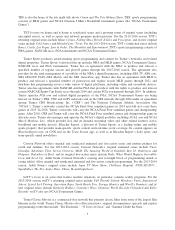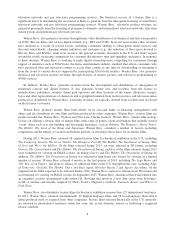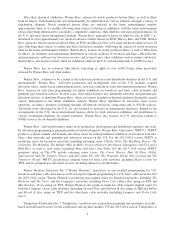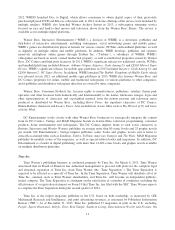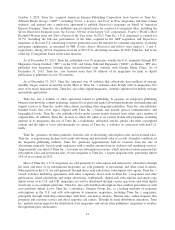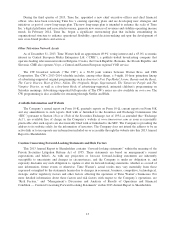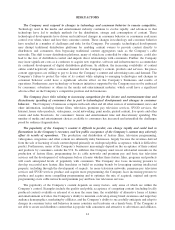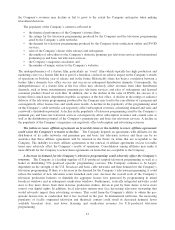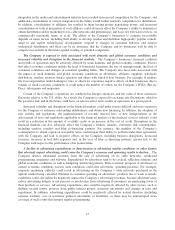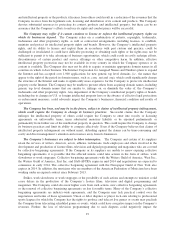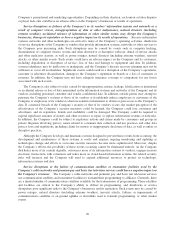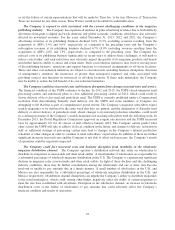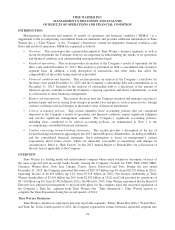Time Magazine 2013 Annual Report Download - page 31
Download and view the complete annual report
Please find page 31 of the 2013 Time Magazine annual report below. You can navigate through the pages in the report by either clicking on the pages listed below, or by using the keyword search tool below to find specific information within the annual report.the Company’s revenues may decline or fail to grow to the extent the Company anticipates when making
investment decisions.
The popularity of the Company’s content is reflected in:
• the theatrical performance of the Company’s feature films;
• the ratings for the television programming produced by the Company and the television programming
aired by the Company’s cable networks;
• the demand for television programming produced by the Company from syndication outlets and SVOD
services,
• sales of the Company’s home video releases and videogames;
• the number of subscribers to the Company’s domestic premium pay television services and international
premium pay and basic tier television services;
• the Company’s magazine circulation; and
• the number of unique visitors to the Company’s websites.
The underperformance of a feature film, particularly an “event” film (which typically has high production and
marketing costs) or a feature film that is part of a franchise, can have an adverse impact on the Company’s results
of operations in both the year of release and in the future. Historically, there has been a correlation between a
feature film’s domestic box office success and success in subsequent distribution channels. Consequently, the
underperformance of a feature film at the box office may adversely affect revenues from other distribution
channels, such as home entertainment, premium pay television services, and sales of videogames and licensed
consumer products based on such film. In addition, due to the decline in the sales of DVDs, the success of a
feature film is much more dependent on public acceptance at the box office. A decline in the ratings or audience
delivery of the television programming produced by the Company may lead to the cancellation of a program and
can negatively affect license fees and syndication results. A decline in the popularity of the programming aired
on the Company’s cable networks can negatively affect subscription revenues, advertising demand and rates and
a network’s distribution potential. A decline in the popularity of television programming aired by the Company’s
premium pay and basic tier television services can negatively affect subscription revenues and content sales as
well as the distribution potential of the Company’s premium pay and basic tier television services. A decline in
the popularity of the Company’s magazines can negatively affect subscription and advertising revenues.
The failure to renew affiliate agreements on favorable terms or the inability to renew affiliate agreements
could cause the Company’s revenues to decline. The Company depends on agreements with affiliates for the
distribution of its cable networks and premium pay and basic tier television services and there can be no
assurance that these affiliate agreements will be renewed in the future on terms that are acceptable to the
Company. The inability to renew affiliate agreements or the renewal of affiliate agreements on less favorable
terms may adversely affect the Company’s results of operations. Consolidation among affiliates may make it
more difficult for the Company to renew these agreements on terms that are acceptable to the Company.
A decrease in demand for the Company’s television programming could adversely affect the Company’s
revenues. The Company is a leading supplier of U.S.-produced scripted television programming as well as a
leader in distributing U.S.-produced episodic programming overseas. The Company continues to be largely
dependent on the strength of the U.S. broadcast and basic cable networks and their demand for the Company’s
television programming. If there is a decrease in the demand for the Company’s television programming, it could
reduce the number of new television series launched each year, decrease the overall scale of the Company’s
television production business or diminish the aggregate license fees generated by programming in initial
broadcast windows and in subsequent syndication windows. Furthermore, vertically integrated networks could
elect to buy more shows from their in-house production studios, driven in part by their desire to have more
control over digital rights. In addition, local television stations may face decreasing television viewership that
would adversely impact their advertising revenues. This could harm the Company’s ability to obtain the per-
episode license fees in syndication that it has received in the past. In international territories, the increasing
popularity of locally originated television and theatrical content could result in decreased demand, fewer
available broadcast slots, and lower licensing and syndication revenues for U.S.-produced television
programming.
15


